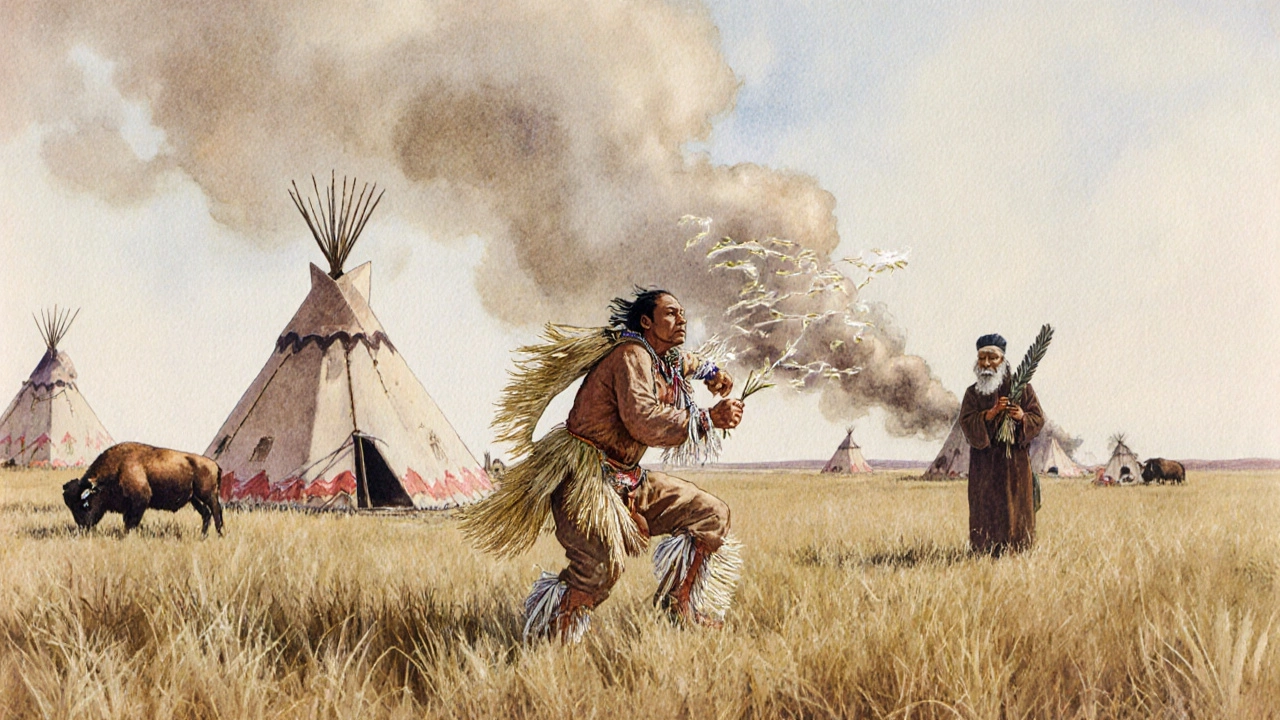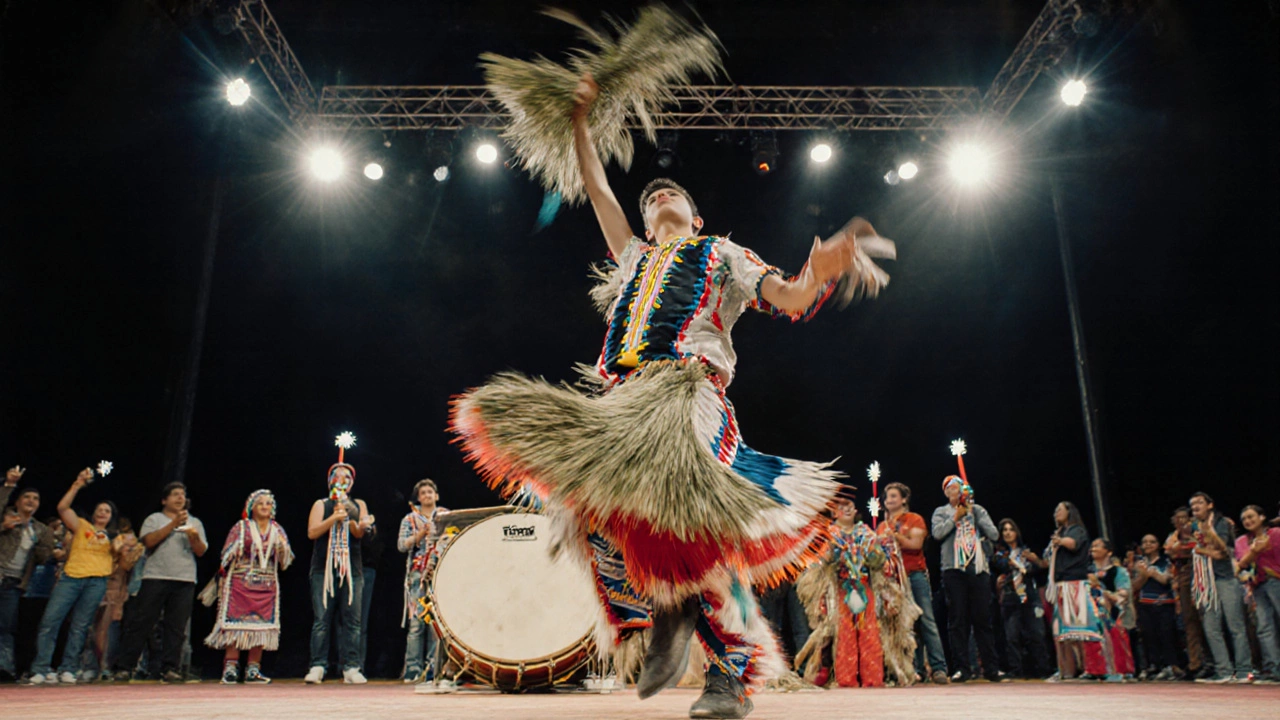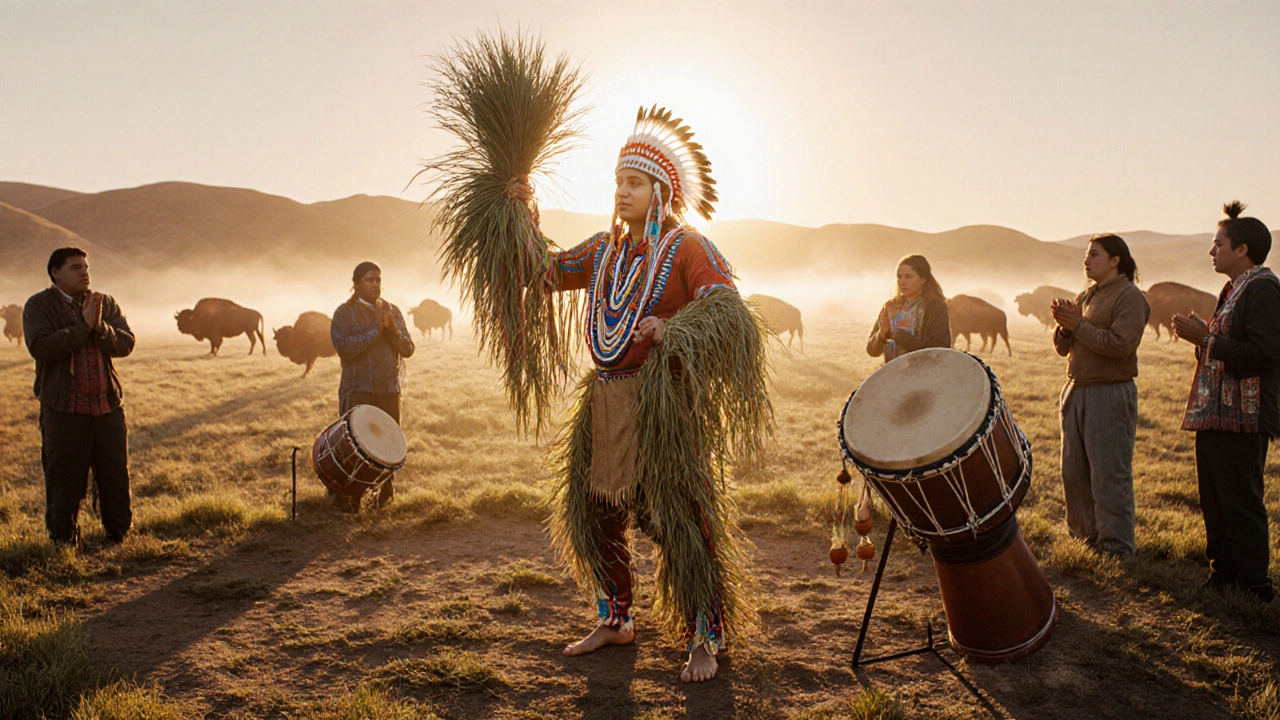Plains Indian Dance Comparison Tool
This interactive tool expands on the comparison table in the article, allowing you to explore detailed information about each Plains Indian dance.
Click on the dance names below to learn more about their significance, regalia, and cultural context.
Grass Dance
A ceremonial dance of the Lakota, Dakota and Nakota peoples performed in spring and early summer to express gratitude to the Creator and pray for future abundance.
Grass Fringe
Long grass fringe on regalia sways with each step, mimicking prairie grass in the wind.
Grass Bundle
Fresh grass tied to forearm symbolically offered to the sky at the dance's climax.
Feathered Headpiece
Symbolizes connection to the spiritual world and the sky.
Key Symbolism
• The grass represents earth's renewal and buffalo sustenance
• Circular movement symbolizes life's cyclical nature
• Stomping creates a thunder-like rhythm symbolizing distant buffalo herds
• Opening prayer connects dancers to spiritual realm
The grass dance is not a competitive event but a communal prayer and healing ceremony performed with reverence, often requiring participants to remove their shoes before entering the sacred circle.
Fancy Dance
A competitive dance originating from various Plains tribes, known for its elaborate regalia and intricate footwork performed during powwow competitions.
Sequined Bustles
Elaborate, colorful bustles with intricate beadwork and sequins that flash as dancers move.
Shiny Fabrics
Reflective materials used in costumes to catch light during rapid movements.
Feathered Headdress
Worn by some dancers to represent status and connection to spiritual forces.
Key Symbolism
• Showsmanship and artistic expression
• Competitive aspect encourages skill development
• Bright colors represent celebration and community pride
• Elaborate regalia often reflects personal or tribal stories
The Fancy Dance differs significantly from the Grass Dance as it focuses on competition and visual spectacle rather than spiritual connection and communal healing. It's performed at all powwow events rather than specific seasons.
Ghost Dance
A spiritual dance created by the Paiute prophet Wovoka in the late 1800s, believed to bring about the return of the buffalo and the resurrection of ancestors.
Simple Clothing
Minimal regalia compared to other dances, emphasizing simplicity and spiritual focus.
Scarves
White scarves or cloth held by dancers during the circular movements.
Woven Belts
Symbolizing unity and spiritual protection.
Key Symbolism
• Symbolizes spiritual renewal and the return of ancestors
• Represents hope for a better future
• The circular dance pattern symbolizes the sun's path and life's cyclical nature
• White clothing represents purity and spiritual cleansing
Unlike the Grass Dance, the Ghost Dance was created as a response to cultural crisis in the late 1800s, rather than as an ancient practice. It's performed in ceremonial circles rather than at regular powwows.
Shoshone War Dance
A dance performed by the Shoshone people to prepare for battle, intimidate enemies, and demonstrate strength before going to war.
Buffalo Hide
Worn by dancers to symbolize strength and connection to the buffalo.
War Paint
Traditional face paint used for spiritual protection and intimidation.
War Clubs
Used in some versions of the dance as symbolic representations of combat.
Key Symbolism
• Preparation for battle and demonstrating courage
• Spiritual protection against enemies
• Connection to ancestral warriors
• Intimidation of potential enemies
The Shoshone War Dance is distinct from the Grass Dance as it focuses on warfare preparation rather than spiritual renewal or communal healing. It's performed specifically before battle rather than at general gatherings.
When you hear the term Sioux grass dance, you’re hearing about a ceremonial performance that has been keeping the Great Plains spirit alive for generations. This dance isn’t just a show-it’s a living prayer, a story, and a reminder of the bond between people, the land, and the buffalo.
What the Sioux Grass Dance Is
Sioux grass dance is a ceremonial dance of the Lakota, Dakota and Nakota peoples, collectively known as the Sioux Nations. It belongs to the larger family of Plains Indians dances that emphasize movement, rhythm, and spiritual connection. The dance is performed on a circular arena called the "dance floor" or "sacred space," and it is led by a designated Grass Dancer who carries bundles of fresh grass tied to his forearm.
Historical Roots and Cultural Significance
The origins of the grass dance stretch back to the mid‑19th century, when the Sioux were coping with loss of buffalo herds, forced relocations, and the trauma of the Indian Wars. Oral histories from Lakota elders recount that the dance was created to honor the spirits of the grass and the buffalo, seeking renewal after a battle or a hardship. Over time, the dance evolved into a Thanksgiving‑style ceremony that thanks the Creator for the gifts of nature and prays for future abundance.
When and Why It Is Performed
The grass dance is traditionally performed in the spring and early summer, when the plains are covered in fresh grass. It can also appear during powwows, seasonal festivals, and community gatherings. Its primary purposes are:
- Healing: The dancer’s movements are believed to transfer positive energy to the audience.
- Thanksgiving: Offering gratitude to the earth and the buffalo for sustenance.
- Commemoration: Honoring warriors who have returned from battle.
Because the dance is both a prayer and a celebration, participants often approach it with reverence, removing their shoes before stepping onto the sacred circle.

Regalia and Instruments
The Grass Dancer’s regalia is a vibrant collage of feathers, beadwork, and, most importantly, a long fringe made of grass that sways with every step. The grass bundle, fresh from the prairie, is gently tied to the dancer’s forearm and is symbolically offered to the sky at the dance’s climax.
Accompanying music comes from a large double‑sided drum and a steady beat of hand‑held rattles made from dried seed pods. The drum’s deep pulse mimics the heartbeat of the earth, while the rattles echo the whisper of grass in the wind.
Steps, Choreography, and Symbolism
The choreography is deliberately fluid, mimicking the movement of prairie grasses swaying in a breeze. Key elements include:
- Opening Prayer: The dancer lifts the grass bundle and whispers a short prayer in the Sioux language.
- Stomping Pattern: Low, rhythmic steps create a thumping sound that reverberates through the floor, symbolizing the thunder of distant herds.
- Spinning Motions: Slow, sweeping turns replicate the circular motion of the sun and the cyclical nature of life.
- Grass Release: At the climax, the dancer gently releases the grass bundle, allowing the blades to flutter to the ground-a visual offering to the spirits.
Each movement is purposeful; the dancer’s body becomes a conduit for the earth’s energy, and the audience often feels a collective uplift.
Modern Revival and Powwow Presence
In recent decades, the grass dance has seen a resurgence thanks to cultural preservation programs led by tribal schools and community centers. Today, you’ll find the dance featured at regional and national powwows, where younger generations learn the steps from elders.
While the core elements remain unchanged, some modern dancers incorporate contemporary fabrics into their regalia, blending tradition with personal expression. However, the essential symbolism-gratitude, healing, and connection-remains untouched.

How the Sioux Grass Dance Compares to Other Native Dances
| Dance | Tribe(s) | Primary Purpose | Typical Attire | Season/Occasion |
|---|---|---|---|---|
| Grass Dance | Lakota, Dakota, Nakota | Thanksgiving, Healing, Warrior honor | Grass fringe, feathered headpiece, beadwork | Spring/Summer, powwows |
| Fancy Dance | Various Plains tribes | Showmanship, competition | Bright fabrics, sequins, feathered bustles | All powwow events |
| Ghost Dance | Various Southern Plains tribes | Spiritual renewal, prophecy | Simple shirts, scarves, no regalia | Late 1800s, ceremonial circles |
| Shoshone War Dance | Shoshone | War preparation, intimidation | Buffalo hide, war paint | Pre‑battle gatherings |
The table highlights how the grass dance stands out for its close relationship to the natural cycle of grass and its emphasis on gratitude, rather than competition or warfare.
Common Misconceptions
- The grass dance is not a competitive dance like the Fancy Dance; it’s a communal prayer.
- The presence of grass does not mean the dance is limited to “outdoor” settings-indoor venues use fresh or preserved grass.
- Only men traditionally perform the Grass Dancer role, but women often participate in the accompanying drum circle and prayers.
- The dance is not a “tourist show.” Authentic performances are protected by tribal protocols and require invited participation.
Frequently Asked Questions
What does the grass symbolize in the Sioux grass dance?
Grass represents the earth’s renewal and the buffalo’s sustenance. By carrying fresh grass, the dancer offers a visual prayer for continued abundance.
Can anyone learn the grass dance, or is it restricted to Sioux members?
Traditional instruction is reserved for tribal members, but many cultural centers host workshops where non‑members can observe and respectfully learn the steps under elder guidance.
Why is the dance performed in a circle?
The circle mirrors the endless cycle of life, the sun’s path, and the community’s unity. Everyone faces the center, symbolizing equality before the Creator.
What instruments accompany the grass dance?
A large double‑sided drum provides the heartbeat rhythm, while hand‑held rattles made from seed pods add a subtle, shushing sound that mimics wind through prairie grass.
How has the grass dance changed in modern times?
Core movements and spiritual intent remain intact, but some dancers now incorporate modern fabrics or color palettes into their regalia. Educational programs have also digitized oral histories, ensuring the dance’s story reaches younger generations.
Next Steps for Curious Learners
If you want to experience the dance firsthand, look for a registered powwow in your region during the summer months. Many events list a "grass dance showcase" in their schedule. For deeper study, reach out to tribal cultural centers-many offer virtual workshops, video archives, and printable guides that respect tribal intellectual property.
Remember, the grass dance isn’t just a performance; it’s a living prayer. Approaching it with respect and curiosity allows you to feel the pulse of the plains, even if you’re watching from across the world.
